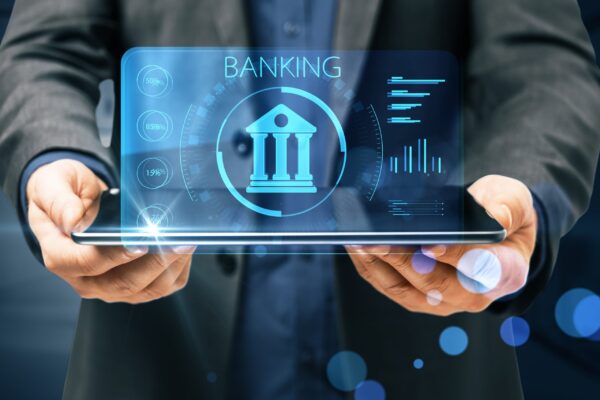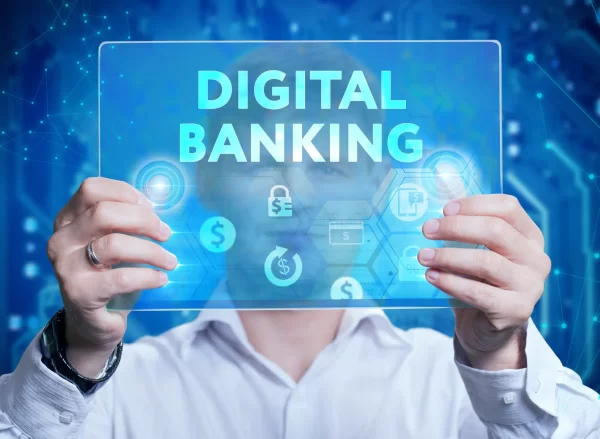Revolutionizing Finance: The Rise of Digital Banking
In an era where technology transforms every aspect of life, the banking industry is undergoing a remarkable evolution. Digital banking, once a futuristic notion, is now a groundbreaking reality, reshaping how we manage and interact with our finances. Let’s dive into this exciting world and explore the cutting-edge innovations, advantages, and future outlook of digital banking.
The Journey to Digital Banking:
Digital banking transcends the boundaries of traditional online banking. While online banking enables basic transactions via the internet, digital banking encompasses a wide range of advanced technologies to deliver a streamlined, customer-focused experience. This shift is driven by the demand for convenience, efficiency, and robust security measures.
Pioneering Innovations in Digital Banking:
- Mobile Banking Applications:
Mobile apps have become the epicenter of digital banking. They offer diverse services, from routine transactions like checking balances and transferring money to more complex tasks such as loan applications and investment management. Banks are continually enhancing these apps with new features to improve usability and security. - AI and Chatbots:
AI-powered chatbots are revolutionizing customer service in banking. These intelligent virtual assistants provide round-the-clock support, answering inquiries, guiding users through processes, and offering tailored financial advice. - Blockchain Integration:
Blockchain technology, the backbone of cryptocurrencies, is making significant strides in banking. Its decentralized structure ensures transaction transparency and security, reducing fraud risk and boosting confidence. - Biometric Security:
To bolster security, many banks are adopting biometric authentication methods such as fingerprint scanning, facial recognition, and voice verification. These methods offer superior security compared to traditional passwords and PINs. - Open Banking:
Open banking facilitates third-party developers in creating applications and services around financial institutions, fostering innovation and competition. It empowers consumers with greater control over their financial data and promotes a more inclusive financial ecosystem.
The Advantages of Digital Banking:
- Unmatched Convenience:
Digital banking eliminates the need for physical branch visits. Customers can perform transactions, access services, and manage accounts from anywhere, at any time. - Cost Savings:
Digital banking reduces operational costs for banks, resulting in lower fees and more competitive interest rates for customers. - Enhanced Security:
With advanced encryption, biometric authentication, and real-time fraud detection, digital banking offers a secure and reliable platform. - Personalized Services:
Leveraging vast data, banks can provide personalized financial products and services tailored to individual needs. - Speed and Efficiency:
Transactions are processed faster, and customer queries are resolved more efficiently through digital channels.

The Future Landscape of Digital Banking:
The future of digital banking is bright, with several emerging trends set to redefine the industry:
- AI and Machine Learning Expansion:
AI and machine learning will continue to be crucial in fraud detection, risk management, and delivering personalized banking experiences. - Cryptocurrency Integration:
As cryptocurrencies gain mainstream traction, banks will incorporate them into their services, offering customers diverse investment opportunities. - Advanced Cybersecurity:
With the rise in cyber threats, banks will invest heavily in cutting-edge cybersecurity measures to protect customer data and maintain trust. - Sustainable Banking Initiatives:
Digital banking can drive environmental sustainability by reducing paper use and promoting eco-friendly practices. - Enhanced Financial Inclusion:
Digital banking has the potential to extend financial services to underserved populations, promoting financial inclusion and economic development.
Conclusion:
Digital banking is more than a trend; it represents the future of finance. As technology advances, so will the capabilities and offerings of digital banks. Embracing these innovations will not only enhance our banking experiences but also pave the way for a more inclusive, efficient, and secure financial ecosystem. Whether you’re tech-savvy or simply seeking to simplify your financial management, digital banking offers a glimpse into a more convenient and efficient future.
FAQs:
1. What exactly is digital banking?
Digital banking involves leveraging digital technologies to provide banking services and processes. This includes online and mobile banking, allowing users to handle transactions, access account details, and manage their finances through digital platforms without needing to visit a physical bank branch.
2. How does digital banking differ from online banking?
Online banking allows for basic transactions via the internet. Digital banking goes beyond this, encompassing a broader range of services and technologies such as mobile apps, AI-driven support, blockchain-based transactions, and biometric security features.
3. What are the key advantages of digital banking?
Digital banking offers several advantages:
- Unparalleled Convenience: Access banking services anywhere, anytime.
- Rapid Transactions: Faster processing and customer service.
- Cost Savings: Lower fees and better interest rates due to reduced operational costs.
- Robust Security: Advanced security measures like biometric authentication and real-time fraud monitoring.
- Personalized Experience: Customized financial products and services based on user data.
4. How secure is digital banking?
Digital banking is highly secure, employing:
- Advanced Encryption: Protects data during transmission.
- Biometric Authentication: Uses fingerprints, facial recognition, or voice recognition for secure access.
- Two-Factor Authentication (2FA): Adds an extra layer of security.
- Real-Time Fraud Detection: Instantly monitors and detects suspicious activities.
5. Can I perform all banking tasks online?
Most banking activities can be done online, such as:
- Checking account balances
- Transferring funds
- Paying bills
- Applying for loans and credit cards
- Managing investments However, certain services, like cash deposits and notarizations, may still require a visit to a branch.
6. What is biometric authentication, and why is it important?
Biometric authentication uses unique physical traits like fingerprints, facial recognition, or voice recognition to verify identity. It enhances security by providing a more reliable and harder-to-fake method than traditional passwords or PINs.
7. How do AI and chatbots enhance digital banking?
AI-powered chatbots offer 24/7 customer support, handle queries, guide users through processes, and provide personalized financial advice. They improve efficiency and customer satisfaction by managing routine tasks and allowing human agents to focus on more complex issues.
8. What trends are shaping the future of digital banking?
Emerging trends include:
- Greater use of AI and machine learning for personalized experiences and fraud detection.
- Integration of cryptocurrencies and blockchain technology.
- Enhanced cybersecurity to combat evolving threats.
- Adoption of green banking practices for environmental sustainability.
- Efforts to improve financial inclusion and accessibility for all populations.
9. How does blockchain technology impact digital banking?
Blockchain technology provides transparency and security by creating a decentralized ledger for transactions. It reduces fraud risk, ensures data integrity, and can streamline processes like cross-border payments and smart contracts.
10. Can digital banking improve financial inclusion?
Yes, digital banking can enhance financial inclusion by:
- Providing access to banking services in remote areas through mobile platforms.
- Reducing the need for physical infrastructure, making banking more affordable.
- Offering tailored financial products like microloans for low-income individuals.




